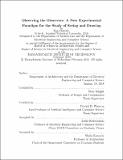| dc.contributor.advisor | Terry Knight and Patrick H. Winston. | en_US |
| dc.contributor.author | Ozgirin, Ege | en_US |
| dc.contributor.other | Massachusetts Institute of Technology. Department of Electrical Engineering and Computer Science. | en_US |
| dc.date.accessioned | 2018-05-23T15:05:30Z | |
| dc.date.available | 2018-05-23T15:05:30Z | |
| dc.date.copyright | 2018 | en_US |
| dc.date.issued | 2018 | en_US |
| dc.identifier.uri | http://hdl.handle.net/1721.1/115630 | |
| dc.description | Thesis: S.M., Massachusetts Institute of Technology, Department of Architecture, 2018. | en_US |
| dc.description | Thesis: S.M., Massachusetts Institute of Technology, Department of Electrical Engineering and Computer Science, 2018. | en_US |
| dc.description | This electronic version was submitted by the student author. The certified thesis is available in the Institute Archives and Special Collections. | en_US |
| dc.description | Cataloged from student-submitted PDF version of thesis. | en_US |
| dc.description | Includes bibliographical references (pages [39]-42). | en_US |
| dc.description.abstract | One way to study how people design is to understand how others observe them designing. I take a step towards this understanding by examining how people segment visual design events temporally, in other words, how they divide these events into smaller pieces. I developed a methodology to comparatively study how multiple observers segment design events. In order to test my methodology, I conducted an experiment. In this experiment, I compared different attributes of a design event to see if some attributes communicate more meaning than others. From the results of the experiment, I observed that the segmentation of the design event was affected more by the gestures of the designer than by the produced designs. My observations suggest computational principles that could be used to develop computational design assistants that better understand designers intentions. | en_US |
| dc.description.statementofresponsibility | by Ege Ozgirin. | en_US |
| dc.format.extent | 42 pages | en_US |
| dc.language.iso | eng | en_US |
| dc.publisher | Massachusetts Institute of Technology | en_US |
| dc.rights | MIT theses are protected by copyright. They may be viewed, downloaded, or printed from this source but further reproduction or distribution in any format is prohibited without written permission. | en_US |
| dc.rights.uri | http://dspace.mit.edu/handle/1721.1/7582 | en_US |
| dc.subject | Architecture. | en_US |
| dc.subject | Electrical Engineering and Computer Science. | en_US |
| dc.title | Observing the observers : a new experimental paradigm for the study of seeing and drawing | en_US |
| dc.title.alternative | New experimental paradigm for the study of seeing and drawing | en_US |
| dc.type | Thesis | en_US |
| dc.description.degree | S.M. | en_US |
| dc.contributor.department | Massachusetts Institute of Technology. Department of Architecture | |
| dc.contributor.department | Massachusetts Institute of Technology. Department of Electrical Engineering and Computer Science | |
| dc.identifier.oclc | 1036987207 | en_US |
